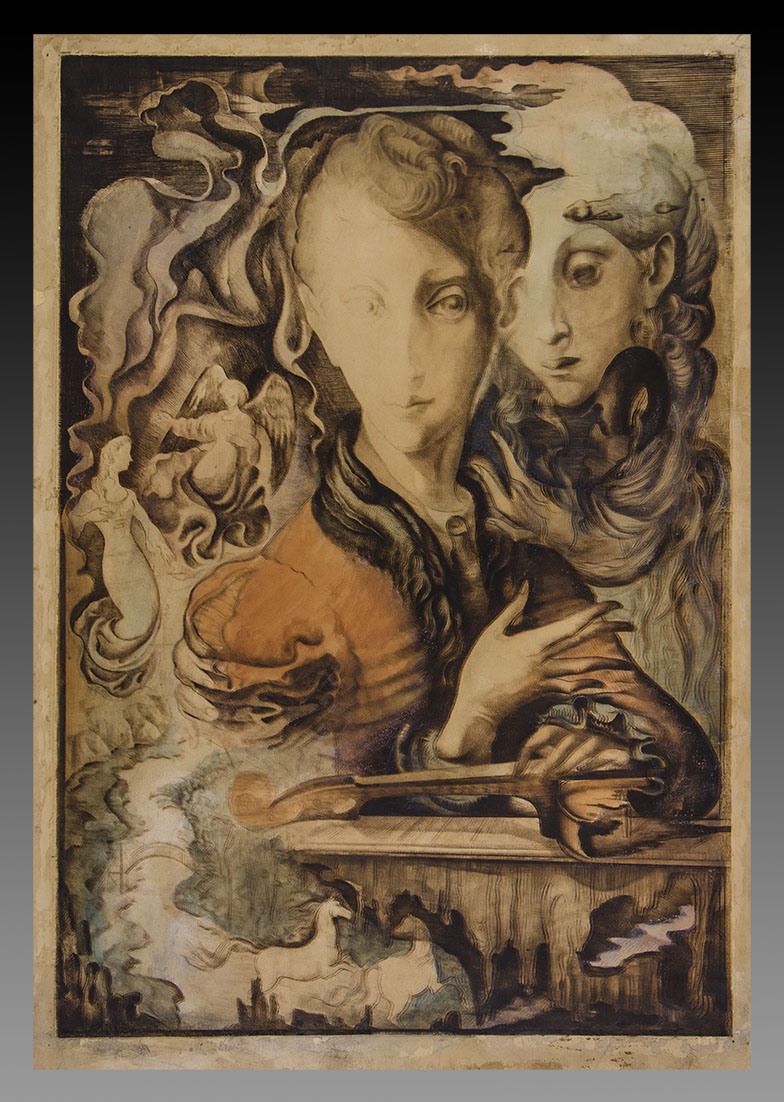CONSECRATED IN THE UNITED STATES AND ARGENTINA
The Omen. 1940-1941
Drypoint on paper, illuminated by hand. On the back, in handwritten form, signed by Luis Barragán: “I certify that this drypoint - hand-colored, is an original engraving by my brother-in-law Mauricio Lasansky. In Buenos Aires, February 8, 1978”. Paper measures: 61.5 x 40.8 cm. The copy seems to reflect an effect caused by the moving plate on the paper, perhaps an artist's proof looking for a “ghost” print; In this line they explain it today in the Lasansky Gallery, we indicate it in the following paragraph. The work is reproduced in Arte Plural. El grabado entre la tradición y la experimentación, 1955-1973 (Edhasa, 2012) by Silvia Dolinko.
In the center, a woman with her face and gaze forward and her torso in three-quarter profile forms the leading figure of the composition. One hand reaches out to her chest while the other holds a broken violin. Behind emerges another woman. The climate is oneiric, surreal, as well as classicist delicacy and detail. What does the scene portend? It is not unreasonable to link it to the Second World War in progress at the time of its creation. An angel announcing himself to a woman -perhaps the same two figures that we see in the foreground-, some horses that go to some caves, or the broken violin are some of the symbols that we observe. The work earned him two prizes in 1941, the Gold Medal of the XX Salón de Rosario, and the first prize in the 1st Municipal Salon of Córdoba, which he rejected because he considered the award less than the value of his work. Undoubtedly, a gesture in which he defended the hierarchy of engraving within the national plastic sphere. We read in the catalog of the Lasansky Gallery, a space located in the city of Iowa (United States) run by the artist's heirs, that the original zinc plate was destroyed, making new prints impossible. It is also noted there that two “ordinary” series were produced, the first printed in sienna and the second in black, and that another exceptional print was executed: a double print with sienna ink and blue-black ink. Our specimen [1] belongs to this last group of tests.
Between August 23 and September 1, 1943, Lasansky held a retrospective show at the Müller Gallery in the city of Buenos Aires, in which he reviewed nine years of graphic production. Silvia Dolinko writes that "the exhibition in Müller was a closing point but also a beginning in his career, before his departure to the United States." [2] After his participation in various group shows in North America since 1938, his trip became a reality when he won the Guggenheim scholarship, thanks to the presentation report that Jorge Romero Brest wrote in 1943, who a few years earlier had sustained in the publication Argentina Libre that Lasansky stood out as "the most promising figure of current Argentine art in engraving". This commentary was included in the catalog of the retrospective exhibition in Müller along with other prominent names in the national artistic world such as Julio Vanzo and Julio Payró and international ones such as René Huyghe, Waldo Frank and the director of the Metropolitan Museum in New York, Francis Taylor. His trip, planned to study the "classics" in the collection of the Metropolitan Museum in New York, finally took a turn when Lasansky was linked to the emblematic Atelier 17 of Stanley William Hayter.
Mauricio Lasansky (Buenos Aires, 1914 - Iowa City, USA, 2012) ventured into engraving together with his Polish father, an artist in this field. He graduated in 1933 from the Superior School of Fine Arts in Buenos Aires. He began his career as director of the Escuela Libre de Bellas Artes in Villa María, Córdoba, and in 1943 he moved to New York. In 1945, he took his first post at the University of Iowa, as visiting professor of graphic arts. Within three years, he would become a full professor and eventually establish his school of printmaking, offering the first Master of Fine Arts program in the United States. Lasansky was a pivotal figure in 20th century graphic art. In the 1960s, he was dubbed "the nation's most influential printer" by Time magazine and identified by Sotheby's as one of the fathers of modern printmaking. In November 1961, the Brooklyn Museum in New York decided to hold a retrospective exhibition for him. He was awarded a Guggenheim Fellowship five times, and a fruitful artistic and academic career that earned him an Honorary Doctorate, Iowa Wesleyan College (1959), an Honorary Doctorate, Pacific Lutheran University (1969), an Honorary Doctorate, Carleton College ( 1979), Distinguished Art Teaching Award, College Art Association (1980), Honorary Award in Arts and Humanities, Commission on Aging (1983), Honorary Doctorate, Coe College (1985), being named an Academician of the National Academy of Arts and Design, New York (1990) and the Iowa Award (1999).
Notes:
1. SEE
2. Silvia Dolinko, Arte Plural. El grabado entre la tradición y la experimentación, 1955-1973. Edhasa, 2012.
| AUTHOR | MAURICIO LASANSKY |
|---|---|
| PRICE | U$S 350 |
Are you interested in selling some works?
Send us an email briefly indicating
which works you intend to put on sale, and we will respond. click here
Subscribe to our newsletter to be updated.
Check our Newsletters